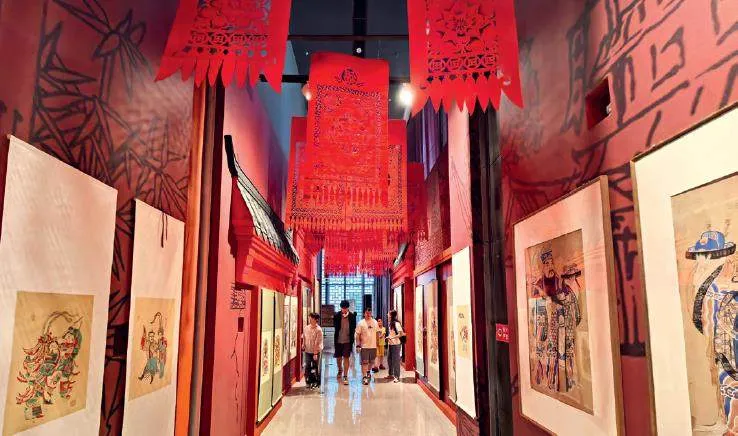Cradle of Culture

Universities, always drivers of new cultures, are now preserving legacy cultures aided by technology.
FILIGREE inlay is a Chinesetraditional intricate metalwork,recognized as anational intangible culturalheritage (ICH). Once regarded as aspecialty of Beijing, it is now makingwaves worldwide as Chineseartists wow international fashionevents such as the London DesignFestival and Milan Fashion Weekwith exquisite filigree inlaid jewelry.
The vitality of this time-honoredChinese handicraft can be tracedback to the Beijing Filigree InlayFactory, one of China’s earliest goldand silver processing enterprises,established in 1958. In 1999, thefactory was taken over by the localadministration to keep it going and renamed the Beijing OrientalYizhen Filigree Inlay Factory. In2022, Zhao Yunliang, a filigree inlaymaestro recognized as an inheritorof the craft, won the first prizeat the Beijing Traditional Craft ArtCompetition.
For ICH that is on the verge ofdisappearing or faces difficultiesin being passed on, local administrationsare taking measures toencourage apprenticeships andprotection efforts from all sectors. ABeijing Municipal Bureau of Cultureand Tourism official said the conditionsof arts and crafts regarded asICH and the challenges they facewill be investigated with multimodalmethods, including written andaudio-video recordings, to document,preserve, and organize them.
ICH Sets New Trend
This year marks two decades ofChina’s ratification of the UNESCOConvention for the Safeguardingof the Intangible Cultural Heritage.China has also founded a Culturaland Natural Heritage Day, celebratedon June 8 every year. The varietyof engaging ICH-based activitieswith local characteristics organizedacross the country on this day createsnew ways to spread traditionalintangible cultural heritage.
The "ICH + tourism" conceptrepresents a new trend in the riseof guochao . Literally meaningnational trend, guochao indicatesconsumers’ rising preference forChinese brands, art and culture.
“An efficient way to preserveICH is through the integration ofculture and tourism, bringing winwinoutcomes for both sectors,”said Yang Ping, dean of the Schoolof Chinese Culture and Communicationat Beijing InternationalStudies University (BISU), who hasbeen conducting research in ICHand cultural communication. "Forthat, it is also important to utilizenatural and cultural heritagethrough rural revitalization andurban planning projects. Nationalcultural parks should be establishedto utilize and protect Chinesecultural heritage.”
Statistics show that Chinaboasts the highest number of ICHitems in the world. By the endof December 2023, over 100,000projects were listed in the national,provincial, municipal, andcounty-level ICH inventories andmore than 90,000 people werelisted as representative inheritors.China's intangible cultural legacyhas added new dimensions to theglobal cultural diversity and is also raising more requirements for theprotection and utilization of theseinvaluable resources.
Yang said China has a wealthof experience in protecting itscultural legacy. It has made andimplemented a series of laws andregulations on cultural heritageprotection and is driving for theinclusion of more of its heritagesites on the UNESCO World Heritagelist. For now, the list includes57 Chinese World Heritage sites.Besides, China participates in theglobal cooperation for the protectionof cultural and biologicaldiversity. Its five national culturalparks are a cultural heritage protectionmodel with Chinese characteristicsand a holistic approachto preserving natural and culturalheritage. Beijing, for instance, hasintroduced a range of regulationsand policies covering all aspects ofICH, including projects, inheritors,protection entities, and promotionand exhibition.
Campus Contributions
Universities play a significantrole in ICH inheritance. Wang Mingyang,a BISU student, has beeninterested in cloisonné since shewas in middle school. "The processof making cloisonné fascinates me,"she said. "When I joined university,I decided I would research it indepth.” Last summer, she and herclassmates visited the CloisonnéMuseum in Dongcheng District,Beijing, to learn about the history,processes, and current situation ofthe craft. They also went throughrecords, policy documents andother materials to understand thecraft better and promote it.
Gao Yuan, a BISU School ofChinese Culture and Communicationstudent, led a student teamstudying innovation and entrepreneurshipto the Gubei Water Town,an ICH-themed resort 140 km fromBeijing, to visit several ICH workshopsthere. They gained handsonexperience in making shadowpuppets and learning how to playthem. They also learned aboutthe artwork of the Lord Rabbitfigurines, which, in Beijing’s localculture, are a symbol of happinessand good luck, and originated inan ancient Chinese tradition ofworshiping the Jade Rabbit on Mid-Autumn Festival.
To research and disseminateChinese cultural heritage, BISU hasconducted a series of themed fieldtrips, including exploring the BeijingCentral Axis and a mobile phonephotography exhibition featuringthe Grand Canal. Yang said, “In thefuture, universities can participatein designing ICH creative products,which will preserve and utilize ICH.ICH bases in colleges can be goodplatforms for teachers and studentsto research ICH and spread itsstories.”
New technologies are widely usedfor ICH communication, such as livestreaming and virtual exploration ofICH.
Beijing held an exhibition of ICHrecently, showcasing many techassistedICH products. At the exhibition,Tangrenfang, a companyproducing Beijing silk figurines, atype of traditional dolls popular inBeijing for centuries, presented itstraditional silk dolls made usingartificial intelligence. Computervision algorithms extract facial featuresfrom 2D photos and create 3Dhead models. Beijing silk figurinesare on the national ICH representativeitem list and the integration ofthis craft with advanced technologiesadds to their charm.
Dongyang, a city rich in ICHsuch as wood carving and bambooweaving, in Zhejiang Province ineast China, has developed an ICHbasedcultural tourism project.Eighteen ICH workshops wereestablished across the town, highlightinglocal arts and crafts. Theyreceived over 2.8 million visitors in2022. The initiative has enhancedthe reputation of local ICH andtransformed local ICH workshopsinto a developed industry, contributingto rural revitalization.
Exploring the Metaverse
Cities like Beijing and Wuhanas well as Guizhou Province havebeen exploring the metaverse andother cross-media interactive technologiesto better promote ICH.These interactive technologies havehelped spread ICH culture both athome and abroad. For example, thevideo game Shadow Fencer Theatercombines the manipulation skillsof shadow play with game mechanics,making it especially appealingto Gen-Z.
Currently, Yang Ping is leading aresearch project that will elucidatethe values and civilizational significanceof Chinese cultural heritageand promote its global influence.It will promote Beijing's CentralAxis cultural heritage abroad, raisingpublic awareness of the valueof China’s world cultural heritagesites, and facilitating cross-culturalcommunication of cultural heritagearound the world.
XUE XIANG is a lecturer at the School ofChinese Culture and Communication, BeijingInternational Studies University, andWANG HAOKUN is a research assistant atthe same institution.

